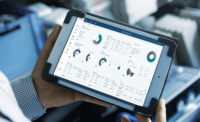Automating the conventional

Current trends and practices in the industry are requiring a change in the way refrigerated and cold storage facilities operate. Order sizes are shrinking while the frequency of orders, as well as SKU counts, are growing. At the same time labor, space and energy costs are still growing. Couple this with the looming issues around Health Care Reform, CFAT, Truck Driver Certification and where current legislation is on Card Check and FoodSafety, and further operational costs can only continue to rise. With all of these issues, it is more and more difficult for companies to maintain their traditional profit base, let alone receive board level approval for large capital investments.
There are no two refrigerated or cold storage facilities alike. Operational issues around commodity, distribution and import/export environments present vastly different handling requirements. Therefore, the point solutions for one may not work well for another. However, all refrigerated and cold storage operations share a common incentive to drive down costs associated with L.E.A.D.S. (Labor, Energy, Accuracy, Damage & Space).
In general, refrigerated and frozen food warehouse and distributors look for short-term, rapid payback solutions that can be implemented within existing facilities. The problem is that educating the market on available automation options has traditionally been poor and hyper focused on large scale automated systems rather than smaller scale solutions with justifiable ROI / IRR.
When it comes to material handling automation, there is a general industry perception that if you are going to consider automation it has to happen when you are planning a new, very large greenfield project. There are, in fact, many automation “point-solutions” that can be implemented within an existing facility. They provide a justifiable ROI, will adapt to changes in your business conditions and have proven successes in refrigerated and frozen environments; effectively reducing your operational costs by 20-30%. With automation you can do more within your existing footprint, expand and add automation or build new. Each approach has its own unique justification based on your unique operation.
This past year, in conjunction with the Global Cold Chain Alliance, I led a research/survey initiative to better understand where the Public Refrigerated Warehouse (PRW) industry was in its readiness to implement automation. One of the more interesting findings was that there appears to be tremendous opportunity for automation point solutions for existing facilities within this segment of the refrigerated and cold storage industry. This is a finding that we are now seeing as a trend throughout the industry as a whole.
Download the white paper
One of the problems this industry faces, though, is that end users have traditionally received little guidance and training on what type of automated technologies are available to them. To date the majority of implementations within this industry tend to begin with WMS and maybe some conveyor and then jump to large ASRS type solutions. There are many automation solutions that fall in between creating a spectrum of opportunities that are typically overlooked and worth understanding.
Automation point solutions can provide ways to eliminate lost or damaged goods, increase picking efficiencies, reduce travel time, eliminate rack and product damage, drastically reduce multiple handling scenarios, increase accuracy and reduce errors. Some technologies can completely automate these processes, others serve as aids to help workers and operators perform more efficiently.
Think about what it would cost you to add an additional 25,000 sq ft to your facility. Then take that figure and cut it in half. I would contend that there are more than a few automation scenarios that you could implement within your existing facility to essentially “free-up” that exact amount of space; all for half the cost of an expansion. How?….through better and more efficient space utilization. Typically conventional storage solutions demand a much larger square footage per load than automation solutions. In 50% of most cases a facility expansion could have been avoided if more dense storage and handling solutions had been considered.
There have been some recent developments in Automated Guided Vehicles (AGV) technology that are worth mentioning. Successful installations of Fork AGV’s to replace counterbalance and VNA vehicles have been completed for multiple end users throughout North America. The AGV’s offer the ability to operate in most any size aisle and can lift up to 35’, all without an operator. Storage into multi deep racking capabilities are expected soon to be realized. For the refrigerated and cold storage industry, AGV’s are now successfully being beta tested in freezer and cooler environments, a big plus for introducing automation into existing facilities. The other advantage that this technology offers is it is not a fixed asset, allowing it to be moved and installed into another facility if desired.
Another technology development is the deployment of stand-alone tray handling ASRS mini-loads for buffering and staging slow moving SKU’s. The base design is a free-standing structure that would replace an existing aisle of pallet storage. The key advantages include reduced labor, reduced travel time for pickers, and the ability to free-up valuable pallet space currently used to store low volume, low case count SKU’s. This technology is currently operational in freezer and cooler environments in North America.
Below are some point solutions for consideration that provide performance improvement potential, with acceptable ROI on an average investment. It also categorizes each on their ability to positively affect L.E.A.D.S. Each technology must be evaluated on their own merit for an individual operation, but I believe this to be a good starting point for automation considerations within an existing footprint.
There is an old proverb that essentially advises that you must “Learn to walk before you run”. In today’s refrigerated and cold storage facilities, the desire to incorporate automation could be best advised by these words “Automate the conventional before you build new”.
Looking for a reprint of this article?
From high-res PDFs to custom plaques, order your copy today!





